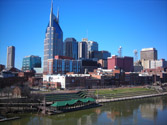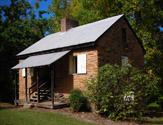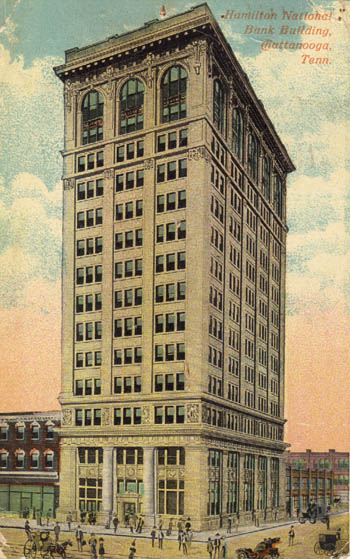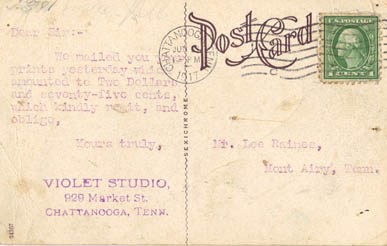















Cotton States Archive
Hamilton National Bank
Chattanooga's Needle in a Haystack
Chattanooga's Needle in a Haystack
If you travel to Chattanooga today in search of the historic Hamilton National Bank building depicted on this post card, you will be hard pressed to locate the structure by merely strolling the streets. It is still standing, but you will need to know a few facts about the building to understand why its whereabouts might prove elusive to architectural buffs.
Designed by Reuben Harrison Hunt (1862-1937) in the Beaux-Arts style, the building was built in 1911, just six years prior to the postmark on this card.
Hailed as the "master builder of Chattanooga," Hunt would gain a regional foothold with branch offices opening in Jackson, Mississippi, and Dallas in 1905 and 1919 respectively. While R. H. Hunt Company was noted for its design of churches (and often provided services free of charge to congregations of modest financial means), the architectural firm was responsible for numerous private residences, hotels, schools, courthouses and other municipal buildings.
In addition to the 17-floor Hamilton National Bank, Hunt designed Chattanooga's James Building (the city's first skyscraper), Memorial Auditorium (opened in 1924), Patten Towers (formerly the elegant Hotel Patten), Solomon Federal Building (a superb example of Art Deco architecture) and the beautiful Maclellan Building (located along Broad Street). Several Hunt structures have been placed on the National Register of Historic Places.
Why might a high-rise of such class and distinguished architecture be so hard to locate? In 1966, the Hamilton National Bank building was masked by a modern facade of steel and glass, and even the interior was altered to accomodate the building's new occupant---the First Tennessee Bank. And, on October 1, 2015, it was announced that Memphis-based Heritage Land and Development Company, LLC would be converting the building into a mixed-use commercial and residential space. In spite of its various makeovers, the structure remains one of the city's tallest buildings and is therefore not very difficult to spot in the cityscape . . . that is, if you know what you are looking for!
Hailed as the "master builder of Chattanooga," Hunt would gain a regional foothold with branch offices opening in Jackson, Mississippi, and Dallas in 1905 and 1919 respectively. While R. H. Hunt Company was noted for its design of churches (and often provided services free of charge to congregations of modest financial means), the architectural firm was responsible for numerous private residences, hotels, schools, courthouses and other municipal buildings.
In addition to the 17-floor Hamilton National Bank, Hunt designed Chattanooga's James Building (the city's first skyscraper), Memorial Auditorium (opened in 1924), Patten Towers (formerly the elegant Hotel Patten), Solomon Federal Building (a superb example of Art Deco architecture) and the beautiful Maclellan Building (located along Broad Street). Several Hunt structures have been placed on the National Register of Historic Places.
Why might a high-rise of such class and distinguished architecture be so hard to locate? In 1966, the Hamilton National Bank building was masked by a modern facade of steel and glass, and even the interior was altered to accomodate the building's new occupant---the First Tennessee Bank. And, on October 1, 2015, it was announced that Memphis-based Heritage Land and Development Company, LLC would be converting the building into a mixed-use commercial and residential space. In spite of its various makeovers, the structure remains one of the city's tallest buildings and is therefore not very difficult to spot in the cityscape . . . that is, if you know what you are looking for!

Construction for Chattanooga's Hamilton National Bank, designed by renowned architect R. H. Hunt, ended six years prior to the June 1917 postmark of this vintage post card.

The reverse of this post card reveals that Mr. Lee Raines of Mount Airy, Tennessee, was being billed for some photographs. Violet Studio, located at 929 Market Street in the heart of downtown Chattanooga, writes: "Dear sir: We mailed you your prints yesterday which amounted to Two Dollars and seventy-five cents, which kindly remit, and oblige . . . " Let it be noted that $2.75 in 1917 was a decent amount of money. Hotel rooms, for example, were less expensive!
(Author's Note: I paid $2.70 for this post card in 2001 at Barber's Orchard Antique Mall near Waynesville, North Carolina. In 1917, Mr. Raines was presumably acquiring an entire package of professional photographs for just a nickel more. Inflation and 84 years can make a big difference!)
BIBLIOGRAPHY
"First Tennessee Bank Building," Emporis. Retrieved May 2007: http://www.emporis.com
"First Tennessee Building Converting to New Housing." WDEF News 12. Retrieved October 7, 2015: http://www.wdef.com
"Historic Neighborhoods & Buildings: Lost: Hamilton National Bank," Cornerstones, Inc. Retrieved May 2007: http://www.cornerstonesinc.org
"Reuben Harrison Hunt (1862-1837)," Tennessee Encyclopedia of History and Culture. Retrieved May 2007: http://www.tennesseeencyclopedia.net
"First Tennessee Bank Building," Emporis. Retrieved May 2007: http://www.emporis.com
"First Tennessee Building Converting to New Housing." WDEF News 12. Retrieved October 7, 2015: http://www.wdef.com
"Historic Neighborhoods & Buildings: Lost: Hamilton National Bank," Cornerstones, Inc. Retrieved May 2007: http://www.cornerstonesinc.org
"Reuben Harrison Hunt (1862-1837)," Tennessee Encyclopedia of History and Culture. Retrieved May 2007: http://www.tennesseeencyclopedia.net
Author: Greg Freeman. Published May 12, 2007. Revised October 7, 2015.
Copyright
Southern Edition
All Rights Reserved
Southern Edition
All Rights Reserved
All materials contained on this site, including text and images, are protected by copyright laws and may not be reproduced without prior written permission from the publisher. Where applicable, use of some items contained on this site may require permission from other copyright owners.
Fair Use of text from SouthernEdition.com is permitted to the extent allowed by copyright law. Proper citation is requested. Please use this guide when citing a Southern Edition article.
Contact Greg Freeman or SouthernEdition.comFair Use of text from SouthernEdition.com is permitted to the extent allowed by copyright law. Proper citation is requested. Please use this guide when citing a Southern Edition article.